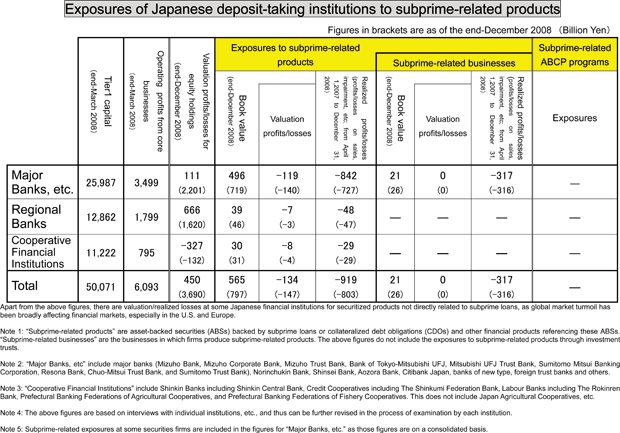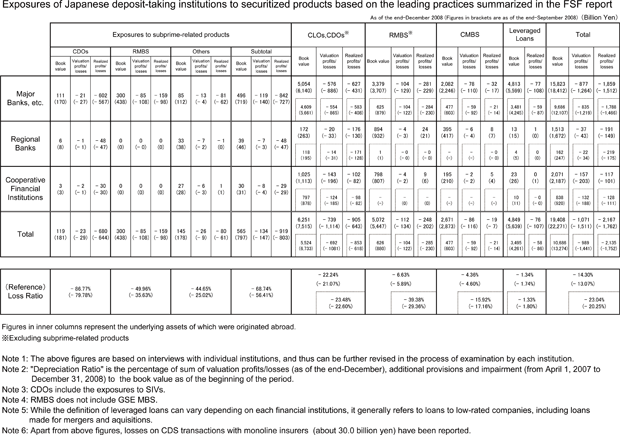 |
 |
Welcome Ceremony for Newcomers(April 1) |
|
[Topics] |
Statements, Speeches & Material
In this corner, we post statements and speeches made by the Minister, the Senior Vice Minister, the Parliamentary Secretary and FSA officials, as well as presentation material they used.
Statement
Policy Statement by Kaoru Yosano, Minister of Finance and Minister of State for Financial Services and Economic and Fiscal Policy, at the Committee on Financial Affairs of the House of Councillors
[Topics]
1. Introduction
On March 10, 2009, the Financial Services Agency (FSA) announced “New Measures for Facilitating Financing.” Intentions and contents of the measures are described below.
2.Points of “New Measures for Facilitating Financing”
With the understanding that one of the major roles of financial institutions is the smooth financing to companies, the FSA has formulated various measures to enhance the circumstance where financial institutions can comfortably provide capital. These include the rapid enforcement of the revised Act on Special Measures for Strengthening Financial Functions, the expansion of the scope of cases where rescheduled loans to small-and medium-sized enterprises (SMEs) are not regarded as non-performing loans, and the introduction of flexibility into the capital adequacy requirements for banks.
In the rapidly weakening global economic environment, SMEs, as well as leading mediumsized and large companies, individuals taking housing loans are facing difficult conditions. With the situation in mind, the FSA has decided this time to take additional measures including implementation of special hearings and intensive inspections, and review of the risk weight concerning emergency guarantees, for smooth corporate financing and personal loans (housing loans).
3. Contents of “New Measures for Facilitating Financing”
(1) Implementation of special hearings and intensive inspections for facilitating financing
(i) Special hearings
For the purposes of understanding in detail the actual status of financial institutions' initiatives for facilitating corporate financing, and of appealing one more time to financial institutions to facilitate their financing toward the end of the fiscal year, the FSA has started special fiscal year-end hearings on an individual basis with, in principle, all banks including major banks, shinkin banks and credit unions from mid-February.
(ii) Intensive inspections
Based on the results of special hearings mentioned in the section (i) above, the FSA will conduct short-term intensive inspections from April through June in the areas of: (1) SME loans; (2) loans to leading medium-sized and large companies; and (3) housing loans; to determine: (a) the status of initiatives for fiscal year-end financing; and (b) the status of credit provision after entering into the new fiscal year, focusing on such issues as the following:
- Whether financial institutions are fully exercising their expected financial intermediary functions.
- Whether they are not exercising those practices that could be regarded as being reluctant to extend credit or as withdrawing credit.
(2) Review of the risk weight concerning emergency guarantees
With regards to loans with emergency guarantee of Credit Guarantee Corporation, considering the fact that they are fully backed by the emergency guarantee system implemented as part of government's measures and funded by the government's budget, it was decided to lower the risk weight attached to these loans from 10 percent to 0 percent in calculating the capital adequacy ratio. Notification of this change has already been announced; and the new risk weight can be applied to financial statements for the fiscal year ending March 31, 2009 and beyond. Q&A explanations and case examples have also been published.
(3) Encouragement of flexible implementation of financial covenants
In the rapidly deteriorating economy, there are a growing number of companies whose business is worse by decrease in sales and so on come to be against financial covenants, which impose obligations , such as maintaining a certain level of net assets, on borrowers in an indenture.
Given this situation, the FSA has clarified, in the “Q&A concerning restructured loans”, that even when financial institutions relax the covenant or waive the right given by the breach of the covenant, they don't have to classify the relevant loan as non-performing loan (restructured loan). In addition, the FSA has requested the financial institutions not to implement the financial covenants too rigidly.
(4) Request for active use of market-oriented indirect financing (syndicated loans)
In the current severe economic downturn, SMEs as well as leading medium-sized and large companies are facing increasingly tight cash-flow situations. In addition, due to the sharp decline in the corporate bond and CP markets towards the end of 2008, companies have shifted their source of financing to borrowing from banks.
In order to respond to the decline in direct financing function and the shift to indirect financing, and from the perspective of promoting risk-diversified financing, the FSA has requested financial institutions to actively use syndicated loans, etc.
(5) Encouraging the use of the Act on Special Measures for Strengthening Financial Functions
With the aim of helping financial institutions properly and fully exercise their financial intermediary functions, the FSA will undertake the following actions to encourage the use of the revised Act on Special Measures for Strengthening Financial Functions:
(i) In light of the objective of the revised Act that aims to restore financial institutions' intermediary functions to the normal state, the dividend yield and other characteristics of public fund capital instruments will be set to the level that is equivalent to normal times.
(ii) Concerning the overhead ratio* that is set in the Management Reinforcement Plan, the FSA will make explicit in its supervisory guidelines that it does not automatically take supervisory actions even in cases where the level of the ratio achieved at the ending period of the Plan has exceeded that of the commencing period.
(iii) Through interviews with top executives of financial institutions and other opportunities, the FSA will induce these institutions to consider the use of the revised Act as well as to consider revising their articles of incorporation that will enable them to issue preferred stocks as a preparation for their potential future capital needs.
Note*: Overhead ratio = Expenses (less IT-related expenses) / Gross banking profit
Exposures of Japanese deposit-taking institutions to subprime-related products and securitized products
On March 6, 2009, the Financial Services Agency (FSA) published the exposures of Japanese deposit-taking financial institutions to subprime-related products and securitized products based on the leading practices summarized in the FSF report as of the end of December 2008.
Subprime-related products held by Japanese deposit-taking financial institutions as of the end of December 2008 totaled ¥565.0 billion (down ¥232.0 billion compared with the end of December 2008), while the total of their valuation and realized losses on such products amounted to ¥1,053.0 billion (¥950.0 billion as of the end of September 2008).
Meanwhile, securitized products held by Japanese deposit-taking financial institutions totaled ¥19,408.0 billion (down ¥2,863.0 billion compared with the end of September 2008), while the total of their valuation and realized losses on such products decreased in 35.0 billion, to ¥3,238.0 billion ( ¥3,273.0 billion as of the end of December 2008).
The main reason why the losses incurred from securitized products have decreased may be that some financial institutions have changed the way to measure fair value of part of their securities.
Since 2008 2nd quarter, the FSA has published the exposures of Japanese deposit-taking financial institutions to subprime-related products and securitized products(*) under unified standards.
We believe that efforts like this help promote a precise understanding of the impact of the turmoil in the global financial markets on Japan's financial system.
The FSA will continue to improve the public access to the current state of the Japanese financial system and the concept of our financial regulation.
(*) As for exposures to securitization products based on the leading practices summarized in the FSF report, the FSA started survey and publication with the exposures as of the end of March 2008.
*For further details, please access “Exposures of Japanese deposit-taking institutions to subprime-related products and securitized products based on the leading practices summarized in the FSF report” (March 6, 2009) in the “Press Releases” section of the FSA's web site.
Site Map
- Press Releases & Public RelationsPage list Open
- Press Releases
- Press Conferences
- Official Statements
- FSA Weekly Review & ACCESS FSA
- Speeches
- For Financial Users
- Others
- Archives
- Laws & RegulationsPage list Open
- Name of Laws and Regulations(PDF)

- Recent Changes (Legislation, Ordinances, Guidelines)
- Guidelines
- Financial Instruments and Exchange Act
- Financial Monitoring Policy
- Public Comment
- No-Action Letter System
- Procedures concerning Foreign Account Management Institutions
 Search
Search





